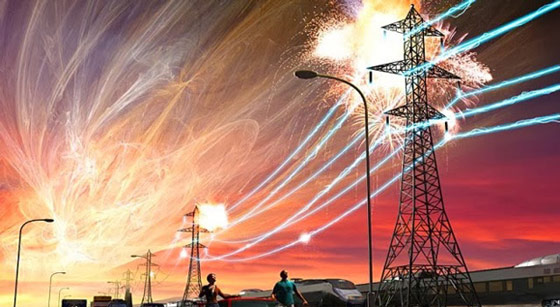This article was originally published by Jon Militimore at The Foundation for Economic Education.
California is hardly the first state to realize that transitioning to renewable energy is easier said than done.
In May, The Wall Street Journal reported that energy grid operators across the US were bracing for rolling blackouts heading into the summer.
“I am concerned about it,” MISO CEO John Bear told the newspaper, noting that green energy sources were struggling to produce enough supply to meet rising demand. “As we move forward, we need to know that when you put a solar panel or a wind turbine up, it’s not the same as a thermal resource.”
Nearly two months later, it’s clear that grid operators were not crying wolf.
On Friday, the Associated Press reported that California—a state desperately trying to “quit” fossil fuels—is seeking to tap fossil fuel to avoid blackouts.
“A sweeping energy proposal Gov. Gavin Newsom signed Thursday puts the state in the business of buying power to ensure there’s enough to go around during heat waves that strain the grid. But some critics say the method of getting there is at odds with the state’s broader climate goals because it paves the way for the state to tap aging gas-fired power plants and add backup generators fueled by diesel.”
Unlike most states, California gets most of its electricity—nearly 60 percent—from renewable sources. But the AP notes the state lacks the storage capacity to dispatch sufficient energy when intermittent energy sources are not producing, something Newsom’s proposal seeks to address.
The governor’s proposal would help “keep the lights on in California,” The Los Angeles Times notes, “making it easier for solar and wind farm developers to sidestep local government opposition, and limiting environmental reviews for all kinds of energy projects.”
The proposal would also likely serve as a lifeline to beachfront gas plants, as well as the Diablo Canyon nuclear plant, the Golden State’s largest power plant and only operating nuclear facility.
‘We Feel Double-Crossed’
At first blush, Gov. Newsom’s proposal makes perfect sense. But there’s more to the story.
As I noted in May, energy industry leaders had made it clear that grids are struggling to keep pace with rising energy demands as plants shift from thermal energy sources to renewables.
But California is already familiar with blackouts.
In August 2020, the state experienced a series of rolling blackouts that captured national attention. (This didn’t stop lawmakers from banning gas-powered generators the following year, something many Californians turned to keep the lights on during the blackouts.)
Following the blackouts, the state water board agreed to allow gas-fired power plants in Redondo Beach, Huntington to continue operating for three additional years, even though they were slated for retirement.
“We feel double-crossed,” Redondo Beach Mayor Bill Brand told the Times. “These retirement dates were set 12 years ago.”
Brand has a point.
Newsom has repeatedly called for the phasing out of fossil fuels and denied that doing so would have an adverse economic effect. His pivot to fossil fuels is prudent because it will reduce the dangerous possibility that Californians will again find themselves without power during the peak heat of summer, but it’s also a betrayal ideologically.
For progressives, California is America’s energy blueprint, the model showing the way forward on “green” energy. Turning back to fossil fuels is a move that runs against Newsom’s own rhetoric and the progressive vision of our energy future. It’s an admission that fossil fuels aren’t just important but necessary to human survival.
We need to phase out our dependence on fossil fuels and focus on clean energy sources.
All new fracking will be reviewed by independent scientists.
There will be no more new permits for high-pressure steam-injected oil drilling in CA.https://t.co/mahfCx6IME
— Gavin Newsom (@GavinNewsom) November 20, 2019
The GOP and oil companies want you to believe that getting rid of oil will hurt our economy.
CA is proof that’s not true — home to nearly half a million green jobs. SIX TIMES MORE than fossil fuel jobs.
Climate leadership & economic growth CAN coexist. pic.twitter.com/hOlVMaPiLD
— Gavin Newsom (@GavinNewsom) November 4, 2021
A Familiar Story
California is hardly the first state to realize that transitioning to renewable energy—which is not as green as many activists and lawmakers would like you to believe—is easier said than done.
General Motors CEO virtue signaling how “clean” the new Chevy Volt is.
Then a reporter asks where the charging electricity comes from.
Oh my…. Wait for it.
Awkward. pic.twitter.com/wcMNhHVSK9
— Benny Johnson (@bennyjohnson) June 8, 2022
In its eagerness to retire coal plants, for example, Hawaii recently found itself using oil to charge the Kapolei Energy Storage Facility—essentially a huge battery designed to utilize green energy—after renewable energy projects were beset by problems.
The revelation was an embarrassment for energy officials, but it revealed an important reality. While many today see fossil fuels as immoral or even evil, the reality is they provide most of the energy in the US and are vital to human existence and flourishing.
This is not to say that renewable energy sources like solar power are not important and cannot serve a key role. They can (though the idea that they come with no environmental costs is untrue).
But the discussion gets at a key lesson of basic economics: tradeoffs exist.
“There are no solutions,” economist Thomas Sowell famously observed. “There are only trade-offs.”
What we’re seeing in California is that the tradeoffs of “green” energy are getting real for politicians. Having $7 gasoline is painful, but bearable. Having the highest energy bills in the country is not desirable, but it can be endured. Blackouts are where politicians seem to draw the line, and it’s not hard to see why.
Unlike many countries around the world, Americans are not accustomed to blackouts, and it seems the political price to them is simply too high—even for politicians who are green energy evangelists.
This article was adapted from an issue of the FEE Daily email newsletter. Click here to sign up and get free-market news and analysis like this in your inbox every weekday.











0 Comments